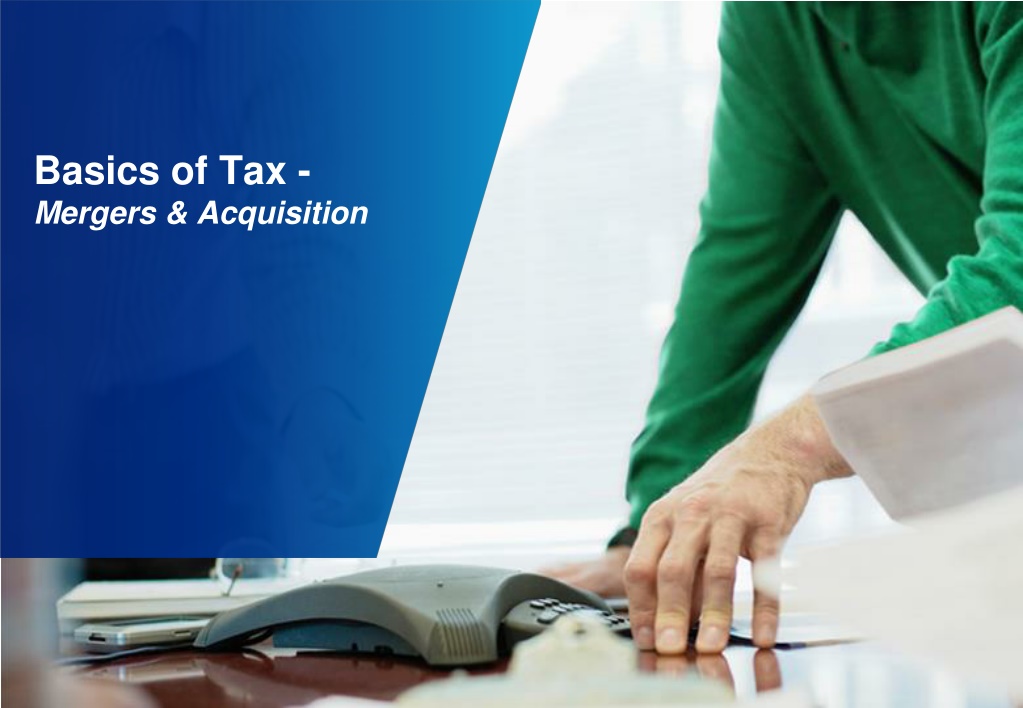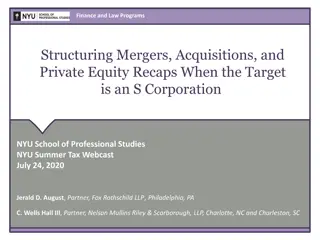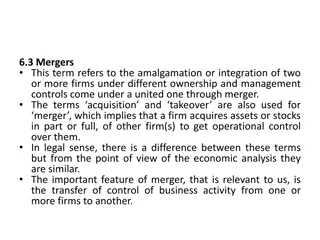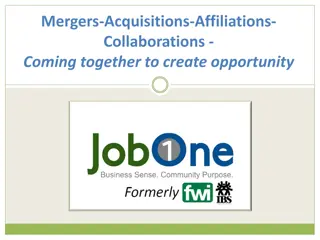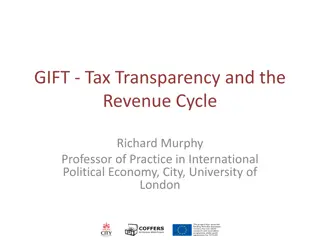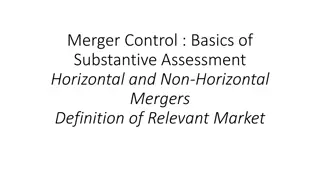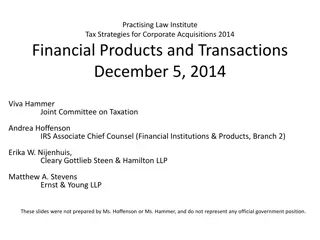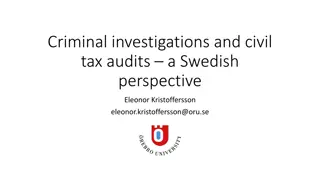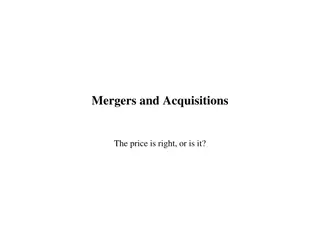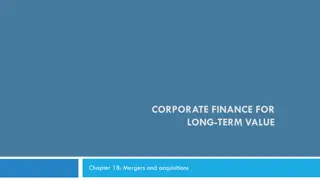Understanding Tax Aspects in Mergers & Acquisitions
This content provides an overview of recent M&A transactions, modes of M&A, taxation and regulatory aspects, as well as case studies in the field of mergers and acquisitions. It covers the need for M&A, various modes of M&A such as amalgamation, acquisitions, and restructuring, and key considerations in M&A structuring. The content emphasizes tax implications, regulatory compliance, and financial considerations in M&A deals.
Download Presentation

Please find below an Image/Link to download the presentation.
The content on the website is provided AS IS for your information and personal use only. It may not be sold, licensed, or shared on other websites without obtaining consent from the author. Download presentation by click this link. If you encounter any issues during the download, it is possible that the publisher has removed the file from their server.
E N D
Presentation Transcript
Basics of Tax - Mergers & Acquisition
Contents 1 Recent M&A Transactions 2 Modes of M&A 3 Taxation Aspects 4 Regulatory Aspects 5 Case Studies
Recent M&A Transactions News Clippings Adani Ports and Special Economic Zone (APSEZ) completes 100% acquisition of Dharma Port from Tata Steel and L&T IDPL for INR 5,500 crore. May 17, 2014 Flipkart buys out Myntra for $300 m May 23, 2014, The Hindu Google sells Motorola to Lenovo for $2.91 billion January 29 , 2014, The Verge 3
Need for M&A Acquisition of Competence or Capability Financial / commercial restructuring Achieve Economies of Scale Need for M&A Diversification Entry into new market/ product Opening up of Indian Economy Attract overseas investments 5
Mergers & Acquisitions (M&A) [1/2] Modes Modes of M&A Amalgamation / Merger Capital Re- organization Acquisitions De-merger Liquidation Capital Reduction Buy-back Share Purchase Asset Purchase Slump Sale Itemized Sale 7
Mergers & Acquisitions (M&A) [2/2] Key considerations under M&A Structuring ..its beyond Tax Scheme of arrangements u/s 391 394 of the Companies Act Approvals from RD/ ROC/ OL Complying with prescribed procedures, resolution, filings etc Accounting implications and disclosures. Understanding the FDI Regulations Seeking necessary RBI/ FIPB approvals Complying with prescribed guidelines Foreign Exchange Regulations Companies Act and Accounting Compliance with SEBI Regulations/approvals Stock exchange compliances Changing Regulatory Environment Understanding state specific stamp duty laws Planning levies/ registration charges Adjudication proceedings etc. Stamp Duty Securities Law c Income Tax Act Indirect Taxes Tax implications in the hands of the Seller, purchase / Transferor Transferee / Company, shareholders Helping maximize depreciation benefit Continuity of Carry forward of losses Tax neutrality of restructuring and continuity of fiscal benefits Sales Tax / VAT applicability on business transfer, mergers / demergers Service tax regulations Impact on stakeholders such as shareholders, creditors and employees also important 8
Merger Merger conditions Section 2(1B) Amalgamation Meaning - Tax Neutrality Merger of one company (B Co.) with another company (A Co.) Merger of two or more companies to form a new company A B Shareholders Shareholders Conditions - all property of transferor company become property of transferee company all liabilities of transferor company become liabilities of transferee company A Co B Co MERGER shareholders holding not less than three fourths in value of the shares in transferor company become shareholders of transferee company (other than shares already held by transferor or its subsidiary company) Companies Act, 2013 permit cross border mergers or amalgamation. However, relevant provisions (sec 234) have not been made effective yet 10
Merger Key tax implications Key tax implications Shareholders No capital gain on transfer of capital assets in the hands of Issue of shares Co. B if Co. A is an Indian company [Sec. 47(vi)]; Co. A Co. B No capital gains in the hands of shareholders of Co. B if : The transfer is made in consideration of shares in the Co. Merger of Co B into Co A A except where the shareholder itself is the amalgamated company, and Issues: Co. A is an Indian company. Whether deduction u/s 80-IA/80- IB/80-IC would be carried forward to amalgamated company Expenditure on amalgamation tax deductible in the hands of Co. A in five equal installments [Sec. 35DD] Whether MAT credit in books of amalgamating co would be transferred to amalgamated co 11
Merger Case study Option 1 Option 2 A B A B Shareholders Shareholders Shareholders Shareholders 75% 75% Issue of shares Issue of shares 25% 25% A Co A Co 75% 75% B Co B Co Merger Merger 25% 25% Merger of B Co. into A Co. A Co. issues shares to B shareholders i.e. 25% shareholders of B Co. Merger of A Co. into B Co. B Co. issues shares to A shareholders i.e. 75% shareholders of A Co. Structure Mechanics Structure Mechanics 12
Demerger Conditions Section 2(19AA) Demerger Tax Neutrality Meaning - Transfer of one or more undertakings of the demerged company (P Co.) to a resulting company (Q Co.) Conditions - All the property and liabilities of the undertaking are transferred. Property and liabilities will be transferred at the respective book values. Resulting Company issues its shares to the shareholders of the demerged company on a proportionate basis [except where the resulting company itself is a shareholder of the demerged company]. At least three-fourths shareholders in value of the demerged company will become shareholders of the resulting company. Transfer of Business Undertaking is on a going concern basis. A B Shareholders Shareholders P Co Q Co A B Demerger of A Business Undertaking includes part of undertaking or unit or division of undertaking or a business activity taken as a whole, but does not include individual assets and liabilities or any combination thereof not constituting a business activity 13
Demerger Key tax implications Key tax implications: Shareholders Shareholders No capital gain on transfer of capital assets in the hands of Co. A [Sec. 47(vib)] Issue of shares No capital gain on transfer / issue of shares [Sec.47(vid)] Expenditure on demerger tax deductible in five equal installments [Sec. 35DD] Company A Company B Bus. A Demerger Bus. A Bus. B Cost of shares in resulting company = (Cost of shares in demerged company) x (Net Book Value of assets transferred/ Net Worth of demerged company pre-demerger) [Sec.49(2C)] Bus. A Actual cost of transferred assets in the hands of Resulting company = Actual Cost in the hands of Demerged company [Explanation 7A to sec.43(1)]; and Issues: Transfer of accumulated loss and unabsorbed depreciation to resulting company allowed [Sec. 72A] Whether deduction u/s 80-IA/80- IB/80-IC would be carried forward to the Resulting co. Where directly relatable to undertaking, such loss; Where not directly relatable, in the proportion of the assets retained and transferred Bus. C 14
Merger & Demerger Demerger Case study Option 1 Option 2 A B A B Shareholders Shareholders Shareholders Shareholders Discharge of Consideration in shares & cash Discharge of Consideration in shares or cash P Co P Co Q Co Q Co A B A B Demerger of A Business Demerger of A Business Manner of Discharge of Consideration Manner of Discharge of Consideration Issue of Shares & payment of cash to all the shareholders. Option given to the shareholders to receive Shares or cash. 60% shareholders received Shares and 40% received cash. 15
Merger & Demerger Continuity of business losses/unabsorbed depreciation in Merger/Demerger Utilization of tax losses & unabsorbed depreciation Section 72A of the Act Amalgamation/ Merger Carry forward of tax losses and depreciation allowed to Amalgamated Company if: - Amalgamating Company o Owns Industrial Undertaking (Manufacturing or processing of goods, computer software, Power Generation/distribution, telecommunication business, mining or construction of Ships, Aircrafts or rail systems) or a Ship or a Hotel. o Has been engaged in the business for 3 or more years o Has held 3/4th of the book value of fixed assets for preceding 2 years - Amalgamated Company o Continues to hold 3/4th of the book value of fixed assets for 5 years o Continues the business for 5 years o Achieve 50% of installed capacity of the undertaking before the end of 4 years from the date of amalgamation & maintain upto 5 years Demerger Benefit of set-off of tax losses & depreciation related to the Demerged undertaking available to the Resultant Co Undertaking need not be an Industrial Undertaking , unlike in Amalgamation Allocation of losses on direct or proportionate basis 16
Merger & Demerger Impact on business losses due to change of shareholding Utilization of tax losses & unabsorbed depreciation Section 79 of the Act Applicable only to closely held companies o companies other than companies in which public are substantially interested No carry forward / set off of accumulated business losses o in case common shareholding of 51% is not maintained as on last day of the financial year Includes all losses except carry forward / set off of unabsorbed depreciation Section not applicable where there is a change in shareholding of an Indian Company which is a Subsidiary of a F Co. as a result of the Merger or Demerger of the F Co. subject to the condition that 51% shareholders of the merging or demerging F Co. continue to be the shareholders of the amalgamated or resulting F Co. This is very relevant in Acquisitions (including global acquisitions) which leads of change of shareholding 17
Merger & Demerger Continuity of business losses/unabsorbed depreciation in Merger/Demerger Case Study 1 Case Study ABC Co XYZ Co A Co X Co Services & Investment business Accumulated Loss Manufacturing business Options Facts of the Case A Co is a closely held company & X Co is a Listed Company Merger of A Co with X Co Availability of losses? 1 Reverse merger of X Co with A Co. Availability of losses? A Co has accumulated tax losses in services business 2 Proposal to consolidate A Co and X Co De-merger of Services business of A Co into X Co. Availability of losses? 3 18
Merger & Demerger Impact on losses due to change of shareholding Case Study 2 Pre - Acquisition Post - Acquisition A Ltd (Listed Co) A Ltd Shareholder B 100% 40% 60% X Ltd Accumulated Losses X Ltd X Ltd is engaged in the business of manufacturing Whether accumulated tax Losses of X Ltd would and selling soaps lapse ? A Ltd proposes to acquire the shareholding of X Ltd Whether possible to protect losses from B 19
Merger & Demerger Impact on due to change of shareholding Case Study 3 Pre - Acquisition Post - Acquisition Shareholder A Shareholder A Shareholder B 100% 40% 60% Q Ltd Accumulated Losses Q Ltd 100% 100% Accumulated Losses P Ltd P Ltd Would accumulated tax Losses of Q Ltd lapse ? A proposes to acquire the shareholding of Q Ltd from B Would accumulated tax Losses of P Ltd lapse ? 20
Merger & Demerger Impact on losses due to change of shareholding Case Study 4 Pre - Merger Post - Merger Shareholder A Shareholder A Shareholder B Shareholder B 40% 60% 40% 60% X Ltd Y Ltd Merger 100% Accumulated Tax Losses Y Ltd X Ltd proposes to merge into Y Ltd Would accumulated tax Losses of Y Ltd lapse ? 21
Merger & Demerger Carry forward of tax incentives and MAT Credit Tax Incentives are either based on business (u/s 80-IA/80-IB/10B) or Area/ Region based (u/s 80-IC/10A /10C) Tax Holidays Continuity of unexpired period of tax holiday to the transferee company in amalgamation / de-merger except u/s Section 80-IA(12A) Explicit provisions not provided for Slump sale in the Act leading to ambiguity on availability or otherwise MAT payable on book profits in the absence of Nil/lower tax profits Credit for MAT allowable to the assessee company who has paid such taxes MAT Credit Amalgamating Co ceases to exist after amalgamation. No specific provision for carry forward of MAT credit in case of amalgamation or de- merger 1. SKOL Breweries vs ACIT (Mumbai ITAT) Recent Judicial precedents allowing the credit to Transferee Company 22
Merger & Demerger Concept and relevance of Appointed Date in Merger/Demerger Concept: Date on which merger/ demerger is deemed to be effective. Appointed Date Choice of Appointed date Not specifically defined in the Act Interpreted based on rulings of the Apex Court The date of amalgamation is the date mentioned in the scheme and approved by the court unless the Court specifies any other date Relevant for tax purposes as it is classified as the date of amalgamation / de-merger Effective Date of Merger April 1, 2014 September 30, 2014 April 1, 2015 Appointed Date Appointed Date Retrospective Prospective 23
Slump Sale / Asset Sale (1/1) Concept and taxability Concept of Slump Sale Transfer of undertaking for lump sum consideration without values being assigned to individual assets and liabilities Undertaking includes any part of the undertaking or a unit or division of an undertaking or business activity taken as a whole but does not include individual assets and liabilities or any combination thereof not constituting a business activity Meaning of Undertaking Slump Sale Capital Gain Computation Capital gain = Slump Sale consideration minus Tax Net-worth of undertaking; Tax Net-worth: Book Value of Non-depreciable Assets + WDV of Depreciable Assets - Value of Liabilities Any change in the value of assets on account of revaluation is ignored. Provisions relating to indexation not applicable. Asset Sale Normal capital gains computation applicable Choice of MNC s Increasing choice of MNC s investing in Indian businesses especially when there are past Tax liabilities/doubts of hidden liabilities Lien of tax authorities on assets transferred Tax Authorities may declare a transaction void if a tax demand is pending against an assessee Tax clearance certificate to be obtained; 24
Slump sale vis--vis Demerger Case Study Mechanics Mechanics Shareholders Shareholders 100% 100% X Ltd X Ltd A A Transfer of Business A Transfer of Business A Issue of shares to X Ltd Issue of shares to shareholders Y Ltd Y Ltd Whether this transaction is demerger or slump sale ?? Whether this transaction is demerger or slump sale ?? 25
Buyback (1/1) Concept and taxability Concept Purchase of own shares by Company - empowered under section 68 of Companies Act, 2013 Out of Free reserves or Securities premium account or Proceeds of a fresh issue of shares or securities other than the proceeds of an earlier issue of shares of the same kind of shares / securities Source Maximum buyback in a financial year = 25% of the company s paid up capital + free reserves Key Conditions Maximum buyback of equity shares in a financial year = 25% of the total paid-up equity capital in that financial year Debt equity ratio not to exceed 2:1 post buy back Permitted for fully paid up shares only Buyback possible in case specified defaults have been remedied and 3 years have passed from time of remedy of default Not permitted out of money borrowed from Banks/ Financial Institutions. Not subject to deemed dividend specifically excluded from definition of deemed dividend u/s 2(22) Key Tax implications Subject to capital gains (long term or short term depending upon period of holding of shares) u/s 46A in the hands of shareholder. New levy on buyback of unlisted shares u/s 115QA introduced by Finance Act 2013 Applicable to domestic companies on buyback under s. 68 of Companies Act, 2013 Levy @ 20% on the company buying back shares on distributed income i.e. consideration paid less amount received for issue Exemption in the hands of shareholder (Section10(34A)) 26
Capital Reduction / Liquidation (1/1) Concept and taxability Capital Reduction: Repayment of excess capital by Company - empowered u/s 66 of Companies Act,2013 Concept Liquidation: dissolution of company and distribution of assets to its shareholders Out of surplus cash / assets with the Company Source To be authorized by Articles of Association Key Conditions Special resolution to be passed by shareholders Subject to approval from High Court/ Tribunal Subject settlement of dissenting creditors Subject to deemed dividend u/s 2(22) (d) / u/s 2(22) (c) read with Section 46 Key Tax implications deemed dividend to the extent of accumulated profits incremental distribution to be treated as capital gains - cost of acquisition available as deduction No indirect tax or stamp duty implications 27
Typical Court process in Merger/ Demerger/ Capital reduction 1 3 2 Drafting of the Scheme of arrangement, finalization of the appointed date, etc Board meetings of Transferor Co. and Transferee Co. to approve the Scheme Application to Jurisdictional HC(s) for Directions for meeting 6 5 4 Holding of shareholders / creditors meeting (if not dispensed) as per the directions of jurisdictional HC(s) Issuing notices to Regional Director (RD) & Official Liquidator (OL) File Chairman s report and petitions with the HC(s) 7 8 9 Final Court hearing(s) and filing the final order with RoC Public notices in newspapers Obtaining NoC from RD & OL, if any Timeline for completion of implementation process ~ 6-8 months Under the Companies Act 2013, National Company Law Tribunal ( NCLT ) would have the powers to approve the High Court Scheme. However, relevant provisions of Cos Act 2013 has not been notified yet. 28
Regulatory aspects of M&A (1/4) Key securities control regulations Concept: Every listed company is required to sign a listing agreement. Listing Agreement As per clause 40(A) of the listing agreement a company is required to maintain minimum level of public shareholding of 25% Approval of stock exchange / SEBI to the Scheme under clause 24(f) of the listing agreement Fairness opinion to be obtained from Merchant Banker Certificate from the Statutory auditor on compliance of Accounting Standards to be obtained Public shareholders can play an active role in approval of Schemes as per revised circular Concept: SEBI to monitor and regulate the control & acquisition of a listed company Takeover Code Any person acquiring 25% or more stake in a listed company shall make mandatory open offer to public shareholders minimum size of mandatory open offer 26% Creeping acquisition of 5% p.a. permitted beyond 25% holding but upto 75% holding without triggering open offer Exemption for Court Schemes available with conditions i.e. Scheme directly involving the Target Co. is exempt while not directly involving the Target Co. is exempt only if cash consideration is <25% of total consideration and post Scheme, atleast 33% of voting rights in combined entity to be held by same persons who held the entire voting rights earlier; The objectives of the Stock Exchanges & SEBI is to protect the interest of the public shareholders 30
Regulatory aspects of M&A (2/4) FDI and Stamp Duty aspects Issue of shares to non resident shareholders pursuant to Scheme (merger/Demerger) of domestic companies is covered under automatic route FEMA FDI regulations to be complied with especially regulated sectors (sectors in which FDI is restricted/prohibited) Reporting requirements as per the RBI needs to be complied with Pricing guidelines to be complied with; Payable on the High Court Order? Stamp Duty Payable on transfer of immovable property and issue of shares 31
Regulatory aspects of M&A (3/4) CCI:: Merger Control Regime - Meaning of Combination Subject to specified limits: CCI Any acquisition of control, shares, voting rights or assets Acquisition of control over an enterprise if the person already has direct/ indirect control over another enterprise in similar product/ service Merger or amalgamation requires mandatory pre-approval from Competition Commission of India (CCI) Overseas transactions with impact on competition in India also covered Exemption for certain routine transactions e.g. Intra-Group restructurings, asset acquisitions etc. 32
Regulatory aspects of M&A (4/4) Changing game & new rules in the old games Companies Act 2013 Now notified Impact of proposed DTC on M&A CFC, GAAR, etc. Exchange Control Regulations FDI, Pricing Guidelines Tax Accounting Standards enacted Game changers Revamp of Stamp Duty provisions Centre and State International Financial Reporting Standards Competition Act Applicability of GAAR Postponed till March 31, 2017 33
MAT Planning Shareholders Mechanics of the Deal 100% A Co. to merge with B Co. under a court approved Scheme of Amalgamation A Co. B Co. B Co. to record listed investments at fair value of Rs. 20 based on purchase method of accounting 1. No MAT on future sale upto Rs. 20 Listed Investments 2. Sale of listed shares exempt from tax if long-term 3. Critical to justify commercial rationale for merger Book Value Rs. 10 Fair Value Rs. 20 35
Indirect transfers Vodafone issue F Co. 1 Mechanics of the Deal 100% Buyer can acquire shares of I Co. or F Co. 2 to acquire Indian assets F Co. 2 Buyer Acquisition of I Co. shares to trigger capital gains tax in India Overseas Acquisition of F Co. 2 s shares whether taxable? 1. If F Co. 2 derives substantial value from I Co., gains taxable in India I Co. 2. Substantial is defined under the Act At-least 50% value of F Co derives based on value of I Co India 36
Listing without IPO Shareholders Shareholders Mechanics of the Deal Issue shares Pursuant to merger / demerger, Unlisted Co. to issue shares to shareholders of Listed Co. 100% Listed Co. Unlisted Co. Unlisted Co. to automatically list without following the IPO process Option 1 Merge Listed Co. into Unlisted Co. Option 2 Demerge a business undertaking from Listed Co. to Unlisted Co. 37
Financial re-structuring Pre Option Liabilities Rs. Assets Rs. Capital 1,000 Net Assets 200 Company can approach the Court to adjust losses against Capital Losses (800) TOTAL 200 TOTAL 200 Net Worth not impacted however, ability to repatriate cash through dividend improves Post Tax implications including MAT liability to be evaluated in detail prior to implementation Liabilities Rs. Assets Rs. Capital 200 Net Assets 200 Losses -- TOTAL 200 TOTAL 200 38
